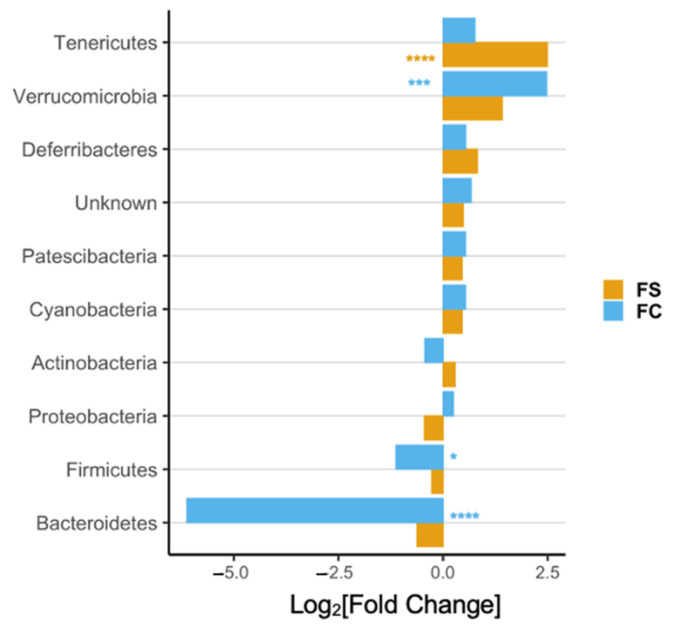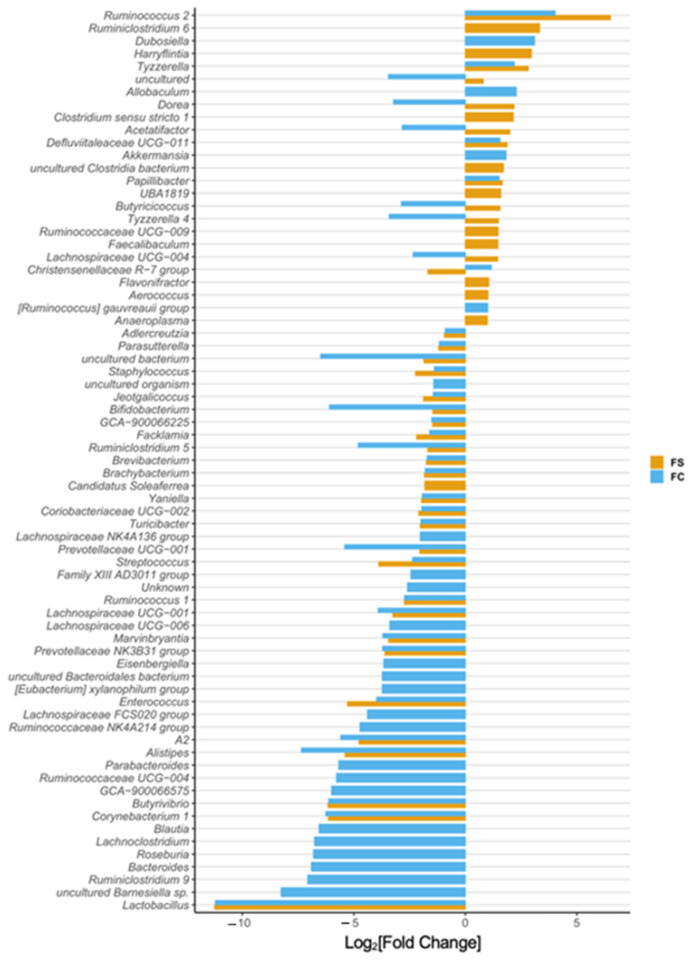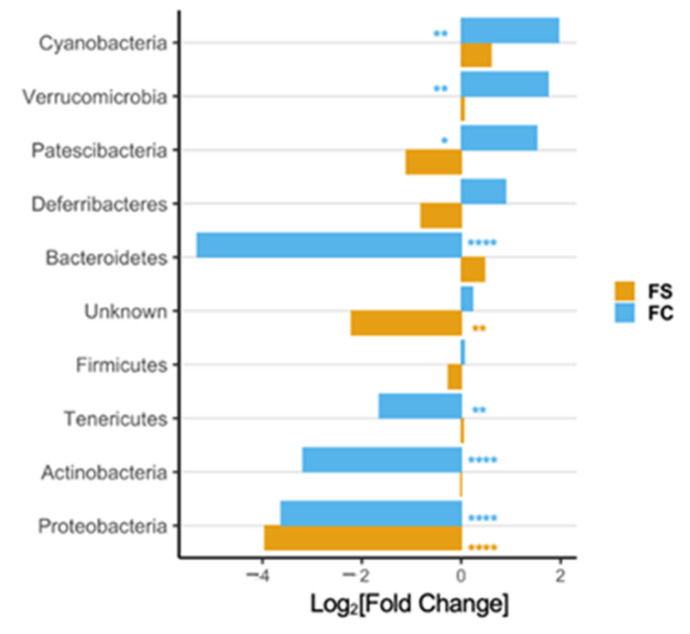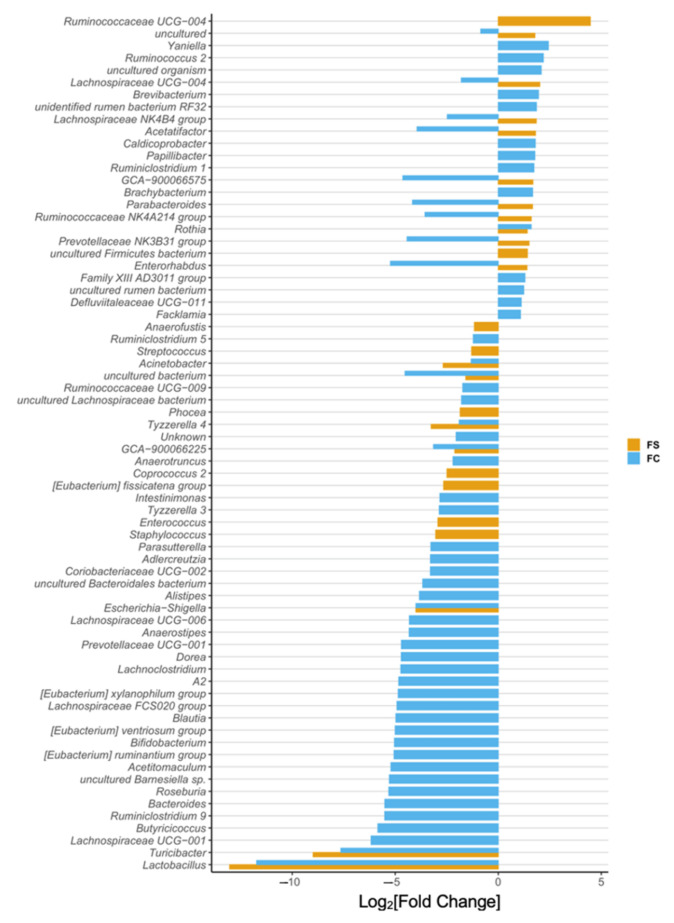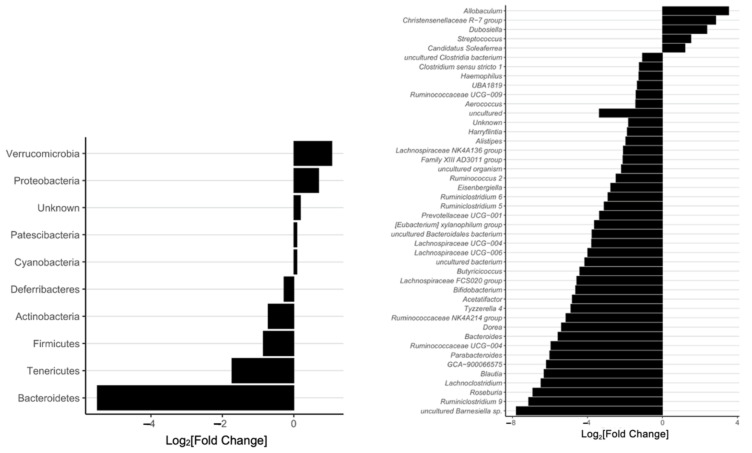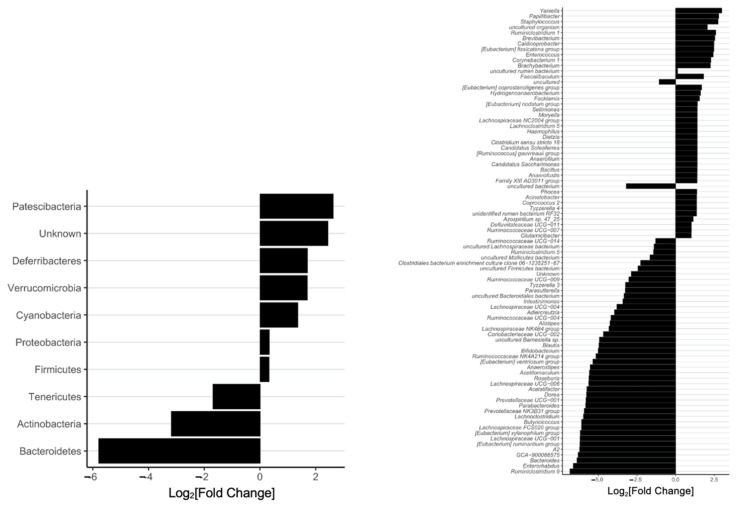Error in Figures and Captions
In the original publication [1], there was a mistake in Figure 2D, Figure 3, Figure 5D, and Figure 6, and Supplementary Figures S3 and S6 and their captions, as published. The x-axes in these figures were mislabeled as Fold-Change instead of Log2[Fold-Change]. The corrected Figure 2D, Figure 3, Figure 5D, and Figure 6, and Supplementary Figures S3 and S6 appear below.
Figure 2.
(D). Differential phyla abundance, represented as log2[Fold Change] from CON for each iron treatment group (n = 27–29/group, 3 litters/group); phyla are ordered by magnitude of change and bars are labeled with color according to iron treatment group.
Figure 3.
Differentially abundant genera due to iron form (n = 27–29/group, 3 litters/group). Differentially abundant genera are represented as log2[Fold Change] from CON for each iron group. Genera are ordered by magnitude of change. Differential abundance was assessed with DESeq2, and FDR-adjusted p-values < 0.05 were considered significant. All significant results are shown in the plot, and their adjusted p-values are listed in Table S4.
Figure 5.
(D) Differential phyla abundance, represented as log2[Fold Change] from CON for each iron group (n = 19–23/group, 4 litters/group); phyla are ordered by magnitude of change and bars are labeled with color according to iron group.
Figure 6.
Differentially abundant genera in young adult (YA) rats due to iron form (n = 19–23/group, 4 litters/group). Differentially abundant genera are represented as log2[Fold Change] from CON for each iron group. Genera are ordered by magnitude of change. Differential abundance was assessed with DESeq2, and FDR-adjusted p-values < 0.05 were considered significant. All significant comparison results are shown in the plot, and their adjusted p-values are listed in Table S8.
Figure S3. Differential abundance of cecal bacteria at the phylum (left) and genus level (right) in FC vs. FS treated pups at PD 15. All genera plotted are significantly different between iron groups. Differential abundance was determined using DESeq2 and FDR-adjusted p-values < 0.05 from pairwise group comparisons were considered significant. p-values are listed in Tables S3 and S4.
Figure S6. Differential abundance of cecal bacteria at the phylum (left) and genus level (right) in YA rats postnatally supplemented with FC vs. FS. All genera plotted are significantly different between iron groups. Differential abundance was determined using DESeq2 and FDR-adjusted p-values < 0.05 from pairwise group comparisons were considered significant. p-values are listed in Tables S7 and S8.
Text Correction
There was an error in the original publication. The fold-change values of differential taxa abundance were not converted from Log2[Fold Change]. Corrections have been made to the following sections:
Abstract:
“Iron provision resulted in 10,000-fold reduced abundance of Lactobacilli in pre-weanling and YA animals provided iron in early life (p < 0.0001).”
Methods, Section 2.8, Paragraph 4:
“Pairwise results were extracted and plotted as log2[Fold Change], and FDR-adjusted…”
Results, Section 3.2.3, Paragraph 1:
“In FC-treated pups we found a 100-fold lower abundance of Bacteroidetes…; Verrucomicrobia were over 6-fold elevated (p < 0.001).”
Results, Section 3.2.3, Paragraph 3:
“Iron-treated pups had a 10,000-fold lower abundance of Lactobacilli compared to CON pups (p < 0.0001); this effect was the largest we observed in all the 73 differentially abundant genera. Bifidobacteria were also less abundant in iron-treated pups (p < 0.05), as were Turicibacter (p < 0.0001), while Ruminococcus 2 relative abundance was elevated (p < 0.0001). Bacteroides and Parabacteroides were 100-fold less abundant (p < 0.0001) in FC compared to CON, but these were uninfluenced by FS treatment.”
Results, Section 3.4.4, Paragraph 1:
“A lower abundance (~10-fold) of Proteobacteria was found in YA rats…”
Results, Section 3.4.4, Paragraph 2:
“Consistent with results in pups, iron-treated rats had more than 10,000-fold lower abundance of Lactobacillus compared to CON rats (p < 0.0001)—the largest effect observed in all 95 differentially abundant genera in YA rats. Turicibacter abundance was 1000-fold lower in iron-treated rats (p < 0.0001). In iron-treated YA rats, but not in pups, abundance of Escherichia-shigella was around 10-fold lower than CON (p < 0.0001), and this effect was similar between FS and FC. Also consistent with pups, Bifidobacterium abundance in FC rats was 100-fold lower than in CON (p < 0.0001), although it was similar between FS and CON; Bacteroides abundance was 100-fold lower in FC rats compared to CON (p < 0.0001) and was comparable between FS and CON.”
The authors apologize for any inconvenience caused and state that the scientific conclusions are unaffected. The original publication has also been updated.
Footnotes
Publisher’s Note: MDPI stays neutral with regard to jurisdictional claims in published maps and institutional affiliations.
Reference
- 1.McMillen S., Thomas S., Liang E., Nonnecke E.B., Slupsky C., Lönnerdal B. Gut Microbiome Alterations following Postnatal Iron Supplementation Depend on Iron Form and Persist into Adulthood. Nutrients. 2022;14:412. doi: 10.3390/nu14030412. [DOI] [PMC free article] [PubMed] [Google Scholar]



